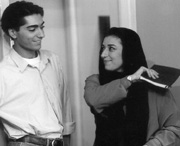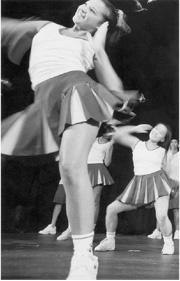REPUTEDLY IRAN’S foremost female auteur, Rakhshan Bani-Etemad has had a tough time getting her films shown. Her last short work, one of six commissioned segments in 1999’s Tales of Kish, was banned for showing too much of her heroine’s hair. Fortunately this 1998 feature, The May Lady, passed the censors—perhaps because of its overtly benign theme of motherhood—and finally receives a Northwest premiere this week. But while the movie keeps the tresses of its middle-aged female protagonist tightly under a chador, it’s also a daring critique of Iran’s rigid social codes that define a woman primarily as mother and wife.
THE MAY LADY
written and directed by Rakhshan Bani-Etemad with Minoo Farshchi and Mani Kasraian runs December 29-;January 11 at Grand Illusion
On the surface, 42-year-old Forugh (Minoo Farshchi) seems like a liberated woman: She’s a successful documentary filmmaker; she’s divorced; she lives in a Tehran apartment decorated with leather furniture and modern art; and her telephone answering machine is filled with messages from a poetic doctor eager to court her. (The film’s title refers to his pet name for her.) However, Forugh refrains from meeting her admirer because her jealous teenage son, Mani (Mani Kasraian), can’t accept the idea of her having a love life. While his protectiveness seems extreme, his feelings are supported by other characters.
Meanwhile, Forugh embarks on a new documentary profiling “exemplary” mothers. The work becomes self-defining as she encounters dozens of ordinary women who speak of hardships not too different from her own. One video clip shows an interviewee who says she’s considering divorcing her second husband because he and his new stepkids—her unaccepting children—fight so often.
If The May Lady shows how restrictive Iran is toward women, it’s also very much a product of those restrictions. It never considers childless women, and Forugh is obviously as guilty as her spoiled, petulant son in reinforcing her own loneliness.
Still, it’s a moving film, filled with evocative images. One recurring scene is that of Forugh driving alone on a zigzagging hillside road as the doctor’s love letters are read in voice-over (shades of Abbas Kiarostami). She repeatedly makes the same turns on the road, reflecting the pendulous forces of sexual desire and maternal duty. Another striking but cryptic motif is a grid of anonymous head-and-shoulders photographs, like those of classroom students, on her living room wall. Several of the pictures are absent, replaced by red “X” marks. Never explained yet blatant, the blanks communicate a terrible void in the good mother’s conflicted life.







